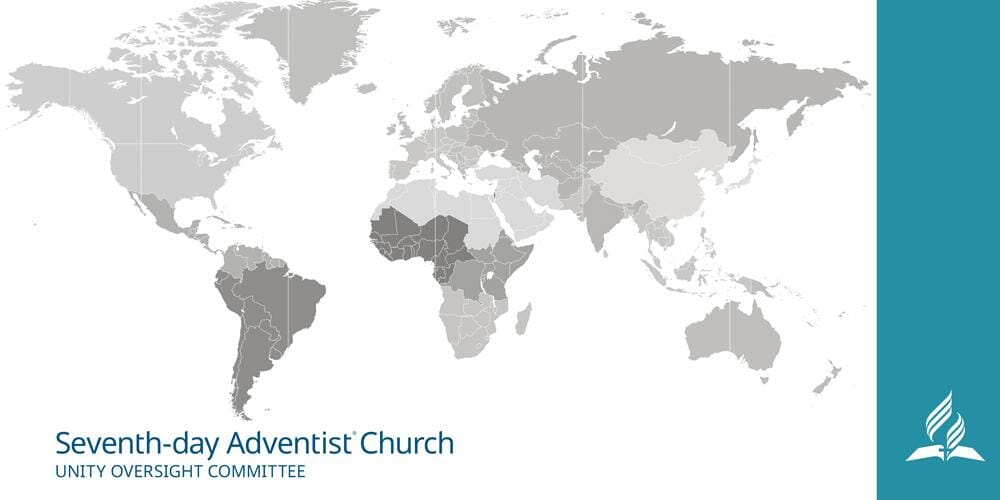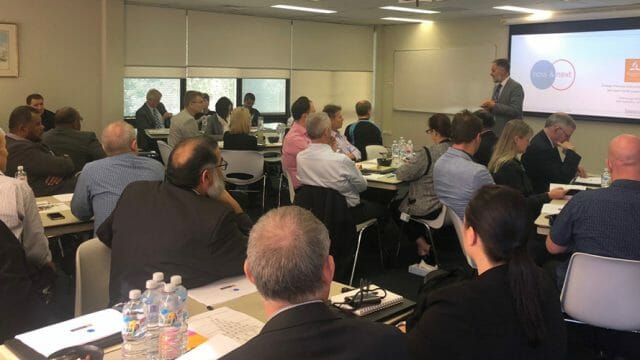Results from a worldwide survey were presented to the members of the Seventh-day Adventist Church’s General Conference (GC) Unity Oversight Committee on March […]

Results from a worldwide survey were presented to the members of the Seventh-day Adventist Church’s General Conference (GC) Unity Oversight Committee on March 20, 2018, during a scheduled meeting held at the world headquarters in Silver Spring, Maryland.
The six-question survey was designed and administered by the church’s Office of Archives, Statistics, and Research (ASTR). The survey addressed issues relating to compliance with voted actions of the General Conference Session, the church’s highest decision-making body, and its Executive Committee, which meets annually between the quinquennial sessions of the General Conference.
Following the process adopted by the Unity Oversight Committee in December 2017, the survey provides quantitative data, allowing the committee “to more accurately judge where the world Church leaders and members stand on these issues,” according to Mike Ryan, chair of the committee. “This information will serve as a guide to the Unity Oversight Committee in defining consequences for unions who have not complied with votes of the GC Session and of the GC Executive Committee,” he added.
The report, presented to the committee by the Director of ASTR, David Trim, featured survey data gathered from the presidents of the Church’s 13 world divisions, as well as the Middle East North Africa Union, an attached field of the GC. In addition, the survey was sent to the 137 presidents of unions around the world.
“The union presidents answer directly to a grassroots constituency,” said Ryan. Additionally, union presidents are members of the GC Executive Committee with an overview of global church events and actions. Unions comprise the constituency of the GC.
Survey Results
In his report, Trim stated that union and division presidents were requested to answer the six survey questions according to “what they believe is the view of the majority of members in their territory, as opposed to their personal opinion.”
Trim noted that 100 percent of the surveys, sent out on January 18, 2018, had been received by March 4. He then presented each question, along with the data received, including 1) number and percentages of “votes” received; 2) number and percentages of Union president “votes,”; 3) Percentage of Union membership living in the territories represented by each vote.
Following are the questions and responses presented to the committee:
Question 1: “Should the General Conference Unity Oversight Committee appoint a team to listen sensitively, counsel and pray with the presidents of unions not in compliance with voted actions of GC Sessions and of the GC Executive Committee?”
Response:
“Yes” — 139 total votes (92%); 126 union president votes (92%); percentage of world membership residing in those unions: 90.56%.
“No” — 10 total votes (7%); 9 union president votes (7%); percentage of world membership residing in those unions: 6.28%.
Not answered — 2 total (1% ); 2 union presidents; percentage of world membership residing in those unions: 3.16%.
Question 2: “Should there be further organizational consequences for unions that do not comply with voted actions of GC Sessions and of the GC Executive Committee?”
Response:
“Yes” — 108 total votes (72%); 97 union president votes (71%); percentage of world membership residing in those unions: 83.93%.
“No” — 34 total votes (22%); 31 union president votes (23%); percentage of world membership residing in those unions: 12.17%.
Not answered — 9 total votes (6%); 9 union presidents (6%); percentage of world membership residing in those unions: 3.9%.
Question 3: “Should church leaders be asked to sign a document saying that they will follow voted actions of GC Sessions and of the GC Executive Committee?”
Response:
“Yes” — 72 total votes (47.7%); 65 union president votes (47.4%); percentage of world membership residing in those unions: 60.6%.
“No” — 77 total votes (51%); 70 union president votes (51.1%); percentage of world membership residing in those unions: 36%.
Not answered — 2 total (1.3 %); 2 union presidents (1.5%); percentage of world membership residing in those unions: 3.4%.
Question 4: “Should presidents of unions not in compliance with voted actions of GC Sessions and of the GC Executive Committee be allowed to speak (i.e. have voice) at meetings of the GC Executive Committee?”
Response:
“Yes” — 76 total votes (50.3% ); 67 union president votes (48.9%); percentage of world membership residing in those unions: 34.3%.
“No” — 67 total votes (44.4%); 63 union president votes (46%); percentage of world membership residing in those unions: 60.9%.
Not answered — 8 total (5.3%); 7 union presidents (5.1%); percentage of world membership residing in those unions: 4.9%.
Question 5: “Should presidents of unions not in compliance with voted actions of GC Sessions and of the GC Executive Committee be allowed to vote in meetings of the GC Executive Committee?”
Response:
“Yes” — 56 total votes (37.1%); 50 union president votes (36.5%); percentage of world membership residing in those unions: 26.8%.
“No” — 86 total votes (57%); 79 union president votes (57.7%); percentage of world membership residing in those unions: 67.9%.
Not answered — 9 total (6%); 8 union presidents (5.8%); percentage of world membership residing in those unions: 5.3%.
Question 6: “Should presidents of unions not in compliance with voted actions of GC Sessions and of the GC Executive Committee be allowed to serve on standing committees or ad hoc subcommittees of the GC Executive Committee?
Response:
“Yes” — 40 total votes (26.5%); 36 union president votes (26.3%); percentage of world membership residing in those unions: 15.5%.
“No” — 100 total votes (66.2%); 91 union president (66.4%); percentage of world membership residing in those unions: 79.1%.
Not answered — 11 total (7.3%); 10 union presidents (7.3%); percentage of world membership residing in those unions: 5.4%.
Conclusions Drawn
The following conclusions were drawn from the collected data:
- There is overwhelming support for a GC team to meet with presidents of unions not in compliance, “to listen sensitively, counsel and pray.”
- There is strong support for some kind of consequences for non-compliance.
- There is also strong support for not allowing presidents of non-compliant unions to serve on standing or ad hoc committees of the GC Executive Committee.
- There is pronounced support for not allowing presidents of unions not in compliance with voted actions of GC Sessions and of the GC Executive Committee to vote in meetings of the GC Executive Committee.
- A majority of Church leaders oppose removing “voice” as well as vote from non-compliant union presidents.
- Most Church leaders also oppose requiring union presidents to sign a document promising to abide by GC Session and Executive Committee actions.
Qualitative Data Gathering Continues
A preliminary report on qualitative data gathering was given by Hensley Moorooven, secretary of the Unity Oversight Committee. Moorooven reported that qualitative data is continuing to be gathered through personal visits and dialogues with division and union leaders worldwide. Qualitative data is also being gathered from GC institutions and the GC Leadership Council, composed of GC officers and departmental leaders.
So far, 11 such dialogues have taken place, according to Moorooven, with many more scheduled for the near future.
“Of the dialogues that have taken place,” added Ryan, “there appears to be a positive correlation between the quantitative and qualitative data.”
Ryan pointed out, however, that in the end, “data is a guide. It can be empirical, but not necessarily infallible, information. It’s a guide, not an absolute. But we will be informed by the data in crafting what is brought to the Executive Committee during Annual Council 2018.”








